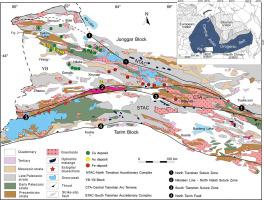Ore Geology Reviews ( IF 3.2 ) Pub Date : 2022-09-21 , DOI: 10.1016/j.oregeorev.2022.105114 Jun Liu , Jing–Wen Mao , Chun–Kit Lai , Xiao–Tong Wang , Jun–Cheng He , Hong–Jing Xie

|
There are abundant porphyry/skarn Cu deposits in the Chinese Western Tianshan (NW China). However, the differences between the ore-related and barren granitoids, and the metal enrichment mechanism remain controversial. The Lamasu–Saibo deposit (0.6 Mt Cu @ 0.3–6.3%) is the first large-scale Cu discovery in the Chinese Western Tianshan. The Cu orebodies are mainly hosted in the exoskarn of the Proterozoic Kusongmuqieke Group. Here, we present a geochemical comparison study of the ore-related and barren granitoids in the Lamasu–Saibo deposit. The ore-related granodiorite porphyry and barren granite porphyry have zircon U–Pb (LA–ICPMS) ages of 381 ± 2 Ma and 379 ± 2 Ma, respectively. Chalcopyrite from skarn ore yielded a Re–Os age of 379 ± 14 Ma. Hence, the Lamasu–Saibo deposit is suggested to be the oldest Cu mineralization in the Chinese Western Tianshan. The granodiorite porphyry and granite porphyry have similar LREE enriched and HREE depleted patterns, typical of average continental crust. The ISr values are calculated to range from 0.707852 to 0.708105 for granite porphyry, 0.708841 to 0.710817 for granodiorite porphyry, respectively. The εNd(t) values of granite porphyry and granodiorite porphyry range from –4.71 to –4.22 and –4.55 to –3.87, respectively. The granite porphyry has 206Pb/204Pb = 18.522 to 18.798, 207Pb/204Pb = 15.552 to 15.569, and 208Pb/204Pb = 38.472 to 38.639; whilst the granodiorite porphyry has 206Pb/204Pb = 18.598 to 18.960, 207Pb/204Pb = 15.544 to 15.566, and 208Pb/204Pb = 38.130 to 38.306. Whole-rock geochemistry and Sr–Nd–Pb isotopes suggest that these granitoids were derived from partial melting of Proterozoic lower crust, and that the parental magma could be metasomatized by subduction-related sediments. The fertile granodiorite porphyry has relatively higher zircon CeN/CeN* ratio (34 – 202, avg. 111), Ce4+/Ce3+ ratio (88–374, avg. 221), Ce/Nd ratio (7 – 23, avg. 15), log ƒO2 (–16.8 to –13.7, avg. –15.6) and ΔFMQ values (–1.0 to +1.5, avg. 0.3) than those of the barren granite porphyry (zircon CeN/CeN* ratio: 5 – 54 (avg. 34); Ce4+/Ce3+ ratio: 14–123 (avg. 73); Ce/Nd ratio: 2 – 10 (avg. 6); logƒO2 value: –17.4 to –14.5 (avg. –16.3); ΔFMQ value: –3.2 to +0.5 (avg. –1.0). The fertile granodiorite porphyry has higher apatite Cl content (0.25 to 0.62 wt%, avg. 0.38 wt%) and lower F/Cl ratio (2.8 to 9.9, avg. 6.7) than those of the barren granite porphyry (apatite Cl content: 0.08 to 0.24 wt%, avg. 0.15 wt%; F/Cl ratio: 9.3 to 29.4, avg. 16.4). This suggests that the fertile granodioritic magma was “wetter” and higher oxidized. Sulfide S–Pb isotope compositions indicate that the ore-forming materials were derived from the granitoids, whilst He isotopes indicate that the ore fluids were dominantly crustal-derived.











































 京公网安备 11010802027423号
京公网安备 11010802027423号